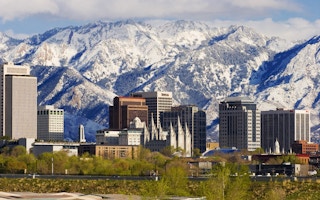It’s just one aspect of the future for just one city among hundreds: researchers have calculated that, for every extra notch on the temperature scale, Salt Lake City in the state of Utah, USA, will face a serious drop in the annual flow of fresh stream and river water to its people.
The fall in flow could be anything from 1.8 to 6.5%. The measure of temperature used by the Americans is Fahrenheit, and 1°F is the equivalent of five ninths of 1°C. But average temperatures in the region have risen 2°F in the last century and are expected to go on climbing.
By mid-century, according to Tim Bardsley from the University of Colorado at Boulder, some of the streams that feed the city will dry up several weeks earlier each summer and autumn. Climate scientists have predicted that the American Southwest could become steadily more arid as the planet warms through a build-up of carbon dioxide in the atmosphere. But city planners need more than general warnings: they need a clear idea of what might happen in this or that environment.
“Because our research team included hydrologists, climate scientists and water utility experts, we could dig into the issues that mattered most to the operators responsible for making sure clean water flows through taps and sprinklers without interruption,” said Bardsley.
Snow is Salt Lake’s lifeblood
He and colleagues report in Earth Interactions that they used climate models to project temperature and rain and snowfall in the region, along with detailed historical analysis to confirm that more of the annual precipitation will fall as rain, rather than snow.
Salt Lake City was the base for the 2002 Winter Olympics: snow is important to the city in more ways than one. Since snow stays where it falls but rainwater runs off immediately, the flow downstream will end significantly earlier in the growing season, as temperatures rise.
In June, scientists forecast a detailed snowfall future for the City of Los Angeles. The Salt Lake City study is just another example of attempts by local authorities to confront a future of global climate change.
“Water emanating from our local Wasatch Mountains is the lifeblood of the Salt Lake Valley and is vulnerable to the projected changes in climate, “ said the city’s mayor, Ralph Becker. “This study, along with otherclimate adaptation work Salt Lake City is doing, helps us plan to be a more resilient community in a time of climate change.”
The researchers confirmed that every increase of 1°F meant, on average, a 3.8% decrease in annual water flow from the city’s watersheds. The lower the altitude of a stream, the more sensitive it was to increasing temperatures, which means that planners have to store more water, or rely on streams from higher altitudes.
On the climate boundary
But events in Utah are hard to estimate. In a warming world, climate scientists expect the US south-west to become much more arid while nd the northern states will experience more precipitation. Utah is poised more or less at the climate change boundary.
The climate models suggest that there would be a more generous flow of water in the winter, but this is the period at which demand is likely to be lowest. To counteract a 5°F rise in local temperatures, the city would hope for at least 10% more precipitation. But a 5°F rise would also mean that peak water flow in the creeks would occur up to four weeks earlier than it does today, which is likely to be a problem for farmers who rely on irrigation.

















